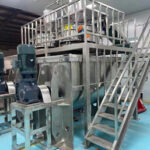Home » paddle blender mix powder
Hope Star's professional knowledge of mixers and feeders
Paddle blenders are well-suited for bulk scale mixing of powders due to their ability to handle large volumes of material and their efficient mixing action. When mixing powders on a bulk scale, several factors must be considered to ensure a successful and efficient process:
Volume: The size of the blender must be selected to accommodate the volume of powder being mixed. Larger blenders are typically used for bulk scale mixing operations, but the specific size will depend on the volume of material being mixed.
Powder Characteristics: The type and size of the powder particles, as well as the powder’s flowability, will affect the mixing process. For example, larger particles may require longer mixing times and higher speeds to achieve thorough mixing.
Viscosity: The viscosity of the powder suspension, if applicable, will also play a role in the mixing process. Thicker suspensions may require slower speeds and longer mixing times to achieve thorough mixing.
Paddle Design: The design of the blender’s paddles can also play a role in the efficiency of the mixing process. Some blenders feature specially designed paddles that are optimized for mixing powders.
Speed: The speed of the blender’s paddles must be adjusted to match the viscosity of the material and to achieve thorough mixing. Faster speeds are typically used for lighter powders, while slower speeds are used for heavier powders.
Overall, when mixing powders on a bulk scale, it’s important to select a blender that is appropriately sized for the volume of material being mixed, and to carefully adjust the blender’s speed and paddle design to match the characteristics of the powder. Regular maintenance and cleaning of the blender can also help to ensure that it continues to operate at peak performance over time.

